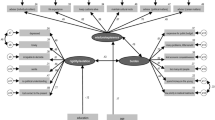Abstract
The purpose of this study was to examine the relationship between the age of an individual, the type of contact an individual has with the elderly, the amount of knowledge an individual has about the elderly, and the extent that the individual stereotypes the elderly. In accordance with the Social Identity Theory and the Contact Hypothesis, stereotyping was predicted to be higher among individuals who did not identify with nor have contact with the elderly. Fifty young (18-25 years of age) and fifty elderly (64-79 years of age) participants completed surveys measuring their level of contact with the elderly, knowledge about aging (knowledge score), and tendency to stereotype the elderly (stereotype score). Results of this study indicated that regardless of age, participant knowledge of aging and application of aging stereotypes were affected by the quality of contact experienced. Although the young participants achieved significantly higher knowledge scores than the elderly participants, there was no significant age difference in stereotype scores for the young and elderly groups. However, as predicted, the young and elderly participants who experienced high levels of contact with the elderly achieved higher knowledge scores and lower stereotype scores. These scores were compared to the respective scores of the young and elderly participants experiencing low levels of contact with the elderly. Moreover, the elderly participants experiencing low levels of contact with the elderly achieved lower knowledge scores than any of the other groups. Elderly participants experiencing low levels of contact with other competent elderly individuals may be more susceptible to the negative effects of aging stereotypes and at risk for not identifying with their own social group.
Similar content being viewed by others
References
Bandura, A. (1981). Self-referent thought: A developmental analysis of self-efficacy. In J.H. Riley & L. Ross (Eds.), Social Cognitive Development: Frontiers and Possible Futures (pp. 200–239). New York: Cambridge University Press.
Brewer, MB., & Miller, N. (1984). Beyond the contact hypothesis: Theoretical perspectives on desegregation. In N. Miller & M.B. Brewer (Eds.), Groups in contact: The psychology of desegregation (pp. 281–302). Orlando, FL: Academic Press.
Butler, R.N. (1989). Dispelling ageism: The cross-cutting intervention. Annals of the American Academy of Political and Social Science, 503, 138–147.
Clark, K.B., & Clark, M.P. (1947). Racial identification and preference in Negro children. In T.M. Newcomb & E.L. Hartley (Eds.), Readings in Social Psychology (pp. 169–178). New York: Holt.
Gaertner, S.L., Rust, M.C., Dovidio. J.F., Bachman, B.A., and Anastasio, P.A. (1994). The contact hypothesis. The role of a common ingroup identity on reducing intergroup bias. Small Group Research, 25, 224–249.
Hogg, M. (1987). Social identity and group cohesiveness. In J.C. Turner, M. A. Hogg, P.J. Oakes, S.D. Reicher, & M.S. Wetherell (Eds.), Rediscovering the social group: A self-categorization theory (pp. 89–116). Oxford: Blackwell.
Kuypers, J.A., & Bengtson, V.L. (1973). Social breakdown and competence. Human Development, 16, 181–201.
Langer, E.J., Fiske, S., Taylor, S.E., and Chanowitz, B. (1976). Stigma, staring, and discomfort: A novel-stimulus hypothesis. Journal of Experimental Social Psychology, 12, 451–463.
Masson, C.N., & Verkuyten, M. (1993). Prejudice, ethnic identity, contact and ethnic group preferences among Dutch young adolescents. Journal of Applied Social Psychology, 23, 156–168.
Perry, D. (1995). Researching the aging well process. American Behavioral Scientist, 39, 52–179.
Peterson, C.C., Hall, L.C., and Peterson, J.L. (1988). Age, sex, and contact with elderly adults as predictors of knowledge about psychological aging. International Journal of Aging and Human Development, 17, 129–137.
Pruchno, R., & Smyer, M.A. (1983). Mental health and aging: A short quiz. International Journal of Aging and Human Development, 17, 123–139.
Rodin, J. (1989). Sense of control: Potentials for intervention. Annals of the American Academy of Political and Social Science, 503, 29–41.
Rodin, J., & Langer, E. (1980). Aging labels: The decline of control and the fall of self-esteem. Journal of Social Issues, 36, 12–27.
Sachdev, I., & Bourhis, R.Y. (1987). Status differentials and intergroup behavior. European Journal of Social Psychology, 17, 277–293.
Tajfel, H., & Turner, J.C. (1979). An integrative theory of intergroup conflict. In W.G. Austin & S. Worchel (Eds.), The social psychology of intergroup relations (pp. 7–24). Monterey, CA: Brooks-Cole.
Wetle, T. (1991). Successful aging: New hope for optimizing mental and physical well-being. Journal of Geriatric Psychiatry, 24, 3–12.
Author information
Authors and Affiliations
Rights and permissions
About this article
Cite this article
Hale, N.M. Effects of age and interpersonal contact on stereotyping of the elderly. Curr Psychol 17, 28–38 (1998). https://doi.org/10.1007/s12144-998-1019-2
Accepted:
Issue Date:
DOI: https://doi.org/10.1007/s12144-998-1019-2




